New Public Domain Hop Breeds
The topic of the characteristics of the new public domain hop as Cashmere, Tahoma, Triple Pearl, and Yakima Gold recently popped up in the Breminaries’ forums. Here’s what Brewmie Bobby Bendily of Bitter and Esters’ had to share:
I have used Tahoma and had beers with Cashmere, Triple Pearl, and Yakima Gold. The problem with new hop descriptors is that they typically come from the growers. It is easy to describe Simcoe and Cascade because people have used them in many beers, but with new hops typically the descriptors come from people smelling a handful of them, and not from actually brewing with them. So, the descriptions can be misleading and the tend to change as people brew with them.
Something worth noting is that since hops have become big business again, the descriptors used have gotten more “colorful.” It used to suffice to call a hop "citrusy," "earthy," or "piney," but that doesn't cut it anymore. With new hop varieties being all the rage, there is a bit of marketing in play. Growers have to make you the brewer wants to try the product, and calling a new hop "spicy" isn't going to get the phone ringing. But when the description says "Notes of Black Pepper, Anise Seed, and Cedar,” you seemingly have a more interesting product.
Cashmere
As for tasting, Cashmere is all it is described to be. However, the coconut aroma was not apparent in either test IPA I tried (and all of us were tasting for it... we were super excited about this hop). The melon and citrusy (mainly lime zesty) was totally there. This was one of the best new hop varieties I have tried in a while. Cashmere is going to be a thing if you ask me.
Tahoma
I used Tahoma in an IPA and I liked it a lot. I used it late (15,10,5, whirlpool and 3oz dry hop) and some of the citrus was there, but the cedar/spicy was so apparent I actually put the beer on Spanish Cedar spirals to play it up even more.
Triple Pearl
The Triple Pearl was used in a single hopped pale ale. It was nice... A little resiny, some of the citrus zest, and little black pepper, like a Pacific Jade, but it was mellow. What stuck out the most was how mellow it actually was. There was a pound in a 10 gallon batch with 4oz dry hop in each fermenter, yet it still seemed very mild.
Yakima Gold
As for Yakima Gold, it is American nobility. It is super reminiscent of Cluster and Comet with a little less of the wild taste to it than Comet. It was in a farmhouse ale and so it wasn't a hop forward beer, but it was dry hopped enough to let the hops show through and was quite an excellent beer.
The bottom line is that Cashmere is a winner and I hope Tahoma catches on. The other two are interesting but not quite as exciting as their counterparts. It is also nice to see growers breeding focused aroma varieties instead of just dual purpose monsters.
Another thing worth noting is that only about 5% of new varieties that come out every year see production beyond 3 years. So, as fun as it can be to try a new hop that doesn't have a name yet, you are taking a risk. Seeing how long a hop has been around and knowing the crop year you are buying can be very valuable. Hop plants produce very little the first year, more the second, and reach their full harvest potential in three years. It’s a gamble for a hop grower to commit an appreciable amount of acreage to an experimental variety. If you are getting your hands on a year one hop as a homebrewer, you typically either have a hook-up, are getting ripped off, or (the more common) the hops isn’t that good.




